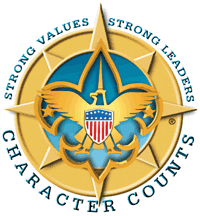|
| |
On March 21, 2009, Scout Jim Bickel presented a research project about Mr. Reuben Brigham
to the 10th annual Montgomery County gathering for National History Day. Since Mr. Brigham served as T264's first scoutmaster in the late 1920s, this material has been modified into a web accessible format to serve as a reference and reminder of the long history behind Troop 264.
Introduction
As part of a competition for an extracurricular activity known as National History Day, I did a research project on Mr. Reuben Brigham, commonly known to you as the troop’s founder. National History Day is a competition that is similar to a science fair for history. This year, the NHD had a theme of legacy. They recommended that we each pick a person from any period of history to research, and to focus on their lasting impact on the community, nation or world. While others focused on more well-known characters such as John Wilkes Booth, Walter Reed or Dr. Bird, I chose a lesser known character that I knew impacted me. Reuben Brigham, I knew, founded our scout troop in 1927. I knew nothing else about him, and didn’t expect much. Instead, I found he left much more than a scout troop behind. Be aware that I write about only what I was able to find out, and it is likely that some information is missing.
Childhood Years and Early Background
Reuben Brigham was born in Marlboro, Massachusetts, on December 13, 1887. His early years were spent growing up on a farm. His father taught him the farming methods himself, and Reuben also went to many different schools. He grew up not only in America, but in several other nations, including Germany and Japan. Sometime, he moved to the United States again and settled in Ashton, MD. He went to the University of Maryland (known back then as the Maryland Agricultural College), and he then graduated in 1908. After his graduation, he farmed for five years until his life became interesting.
Parcel Post
Ever wonder how that package came to your door? Ever wonder who started the Parcel Post? Farmers in the United States long wanted a government parcel service, due to the high prices that private companies would require. You often had two choices with items. You could pay more than half the worth to ship your products east or you could let them rot while you haul them yourself over the Appalachian Mountains. The reverse was true with getting something. If you needed, say, a Model-T car-to-tractor conversion kit so you could use a gasoline engine instead of a stubborn mule to plow your fields, you would have to pay the evil railroad companies more than twice the value of the kit to ship it to where you could pick it up, or you could take the dangerous route east yourself to get the part, leaving your farm unattended and spending hard-earned cash on gasoline and such. The National Grange, a large nationwide organization that farmers used to unionize and advocate for farmer rights, had turned a blind eye to it. Mr. Brigham, of the Olney Grange, wasn’t about to let a good plan go to waste. (The Olney Grange was a branch of the Maryland Grange, a branch of the National Grange, which was formed as unions won battles in industry while envious farmers still struggled.) By encouraging congressman David J. Lewis to test its soundness in Congress, he managed to get it through. There were many points at which the Honorable David J. Lewis admitted he felt like giving up. He said that through Mr. Brigham’s bottomless enthusiasm, he managed to gain enough support to get the legislation passed. Farmers and city folks nationwide loved it. A farmer now did not have to spend near as much to get a stupid part, so he was able to expand his farm more rapidly, and the customers ended up paying much less due to the significantly lowered shipping costs. The only downfall to this legislation was that the railroad companies were going bankrupt (eventually leading some of them to unite as CSX.) So next time you receive a package at the door, think about how it all started-from that same man who founded our scout troop.
The Agricultural Department
Ever hear about the United States Department of Agriculture? (You know, that government agency that inspects meat, leaving a sticker on it if it looks good enough?) It was originally started to help farmers and ranchers become educated about their actions, work, and sanitation, and to clean up the meat-packing industry scandals. According to the Agricultural Extension Service, he was called to the Department of Agriculture in 1917 to take charge of producing visual and editorial materials. After serving a year in the army, he returned to the agricultural department. He worked in the Agricultural Extension Service, which was created for the purpose of gathering the above stated materials. In the Extension service, he created a magazine which is still published today, known as the Agriculture Extension Service Review. In 1933, he was placed in the Agricultural Adjustment Administration (remember learning about FDR’s New Deal in History Class?). There he developed a regional contact division, which was used as a public relations committee for the AAA and other depression and wartime agencies. (The AAA was later deemed unconstitutional by the Supreme Court.) Another of his extension jobs was being the 4-H Club leader to Maryland, and he eventually became the top figure in the national 4-H Club. The 4-H Club was an organization founded to teach farm youth the basics of farming and how to do it the right way (preventing anther Dust Bowl), and to give farm youth a proper education and upbringing. In his work, Mr. Brigham was very dedicated. He would not give the people he needed to contact a telephone call or a proper letter, but instead he would go out there in person and talk and become friendly with the farmers. He was so attached to his work that he died of an ailment when he went out west to contact a few farmers in 1946.
Mr. Brigham and War
In 1918, a year after Reuben joined the Agricultural Department, he joined the army. He fought as one of millions of “doughboys” fighting in WWI for the Allies against the Central Powers. He only fought for a single year, and not too much is known about his actions, most likely because he was no one of high rank. Reuben’s children were all involved in WWII. His son, David Brigham, served in the Pacific, and his other son served in Europe. His daughter became an army nurse. Mr. Brigham understood how the Axis Powers saw the war from their point of view, instead of just the Allied view, having grown up in Japan and Germany himself.
Mr. Brigham and Family
As stated before, Mr. Brigham’s father had dragged Reuben’s childhood all over the world. Mr. Brigham married Marjorie Snowden on June 7, 1915 at Ingleside (Queen Anne's County, MD). Mr. and Mrs. Brigham were devout Quakers, and played a role in the Sandy Spring Friends group. As stated before, Reuben had three children. His first son, David Lewis Brigham, was named after Congressman David J. Lewis, a friend to Mr. Brigham. He had a second son, whose name I cannot find. His daughter, born on February 22, 1922, was named after her mother, to become Marjorie Amber Brigham. Marjorie, (the daughter) is still alive. She lives in Vermont, and helped me with my MDHD project. David Brigham married Gladys Beall in Rockville on December 28, 1938. David and Gladys Brigham had a son, who was also named David. This David Brigham, grandson of Reuben Brigham, is the person who has his name on a plaque on the bell structure in front of Sherwood High School. David Brigham Sr. died in 1999, and he had written a memoir about his father for the troop (also posted on the website). Reuben, having died in 1946, is buried on his property in Ashton next to his wife, Marjorie.
Property and House
|
Mr. Brigham bought his property from Francis Snowden in 1921. He built his house, named Glyndon, and that house still stands. It is visible at 1022 Olney-Sandy Spring Road, Ashton, MD. Our troop used to do our annual primitive there, but due to a problem with the neighbors, we have used the Haviland property as a substitute. (I will not discuss this too much, because I am bound to get it wrong, not knowing all the details.) On his property, he and his wife are buried as previously stated side-by-side. Besides the grave markers, there are different memorials honoring him, one from the American Legion Post #68, (which he helped found after WWI and which is still the sponsor of the troop), another from the University of Maryland Class of ’08 (1908, not 2008), and another from “Friends in Agriculture”.
| 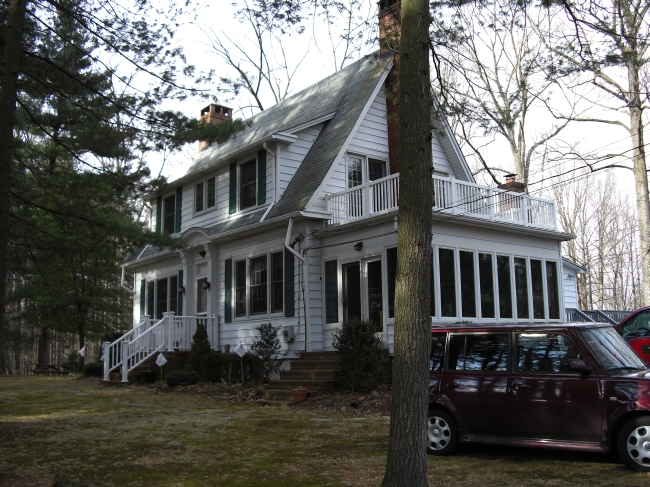
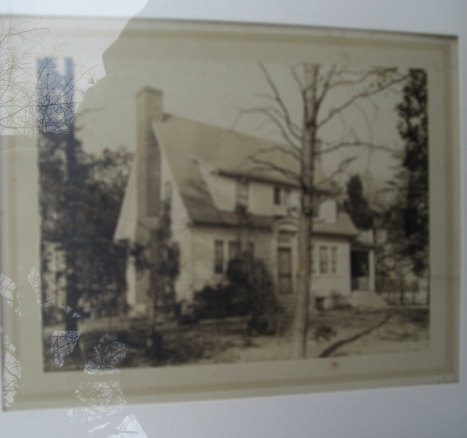
|
Brigham and Youth
Mr. Brigham believed in the proper upbringing of rural youth. This is visible through the 4-H clubs he was involved with. David Brigham Senior has already written his brief memoir about the Troop’s history, so I shall not restate that. To access it, follow this link: https://troop264olney.net/history.html .
Conclusion and Further Help
Mr. Brigham was a very active fellow, especially in the 59 years that he lived. Mr. Brigham was very good subject matter to me to research. I would like to thank the cooperation of his family members and descendants, the Sandy Spring Museum, the Montgomery County Historical Society, the Maryland Historical Society, the National History Day, and especially, the support of my family and teachers. Anyone who needs more information on Reuben or photocopies of original sources can contact me at connect264@verizon.net for through the troop information or bickeldc@verizon.net for out of the troop. The color photographs in this article are taken by me, and need no permission to be duplicated. If contacted, I can send you the full sized images instead of the downsized ones placed in this article. The black-and-white photographs were provided by the Brigham family. I give permission for this article to be copied as long as proper credit is given.
For Your Bibliography
| Author of text | Jim Bickel |
| Date written | March 21, 2009 |
| Title | Reuben Brigham: Legend Unveiled |
Bibliography
Primary SourcesWorks Cited
- Annals of Sandy Spring History Volume IV. Sandy Spring, MD: Sandy Spring Friends [Quakers], 1930.
This is a local book published by the Quakers living in the Sandy Spring area that records major and minor events, with each volume having a different time span. This source was used to draw specific details about Reuben after he moved to the area.
- Annals of Sandy Spring Volume V. Sandy Spring, MD: Sandy Spring Friends [Quakers], 1950.
This is a local book published by the Quakers living in the Sandy Spring area that records major and minor events, with each volume having a different time span. This source was used to draw specific details about Reuben after he moved to the area.
- “Reuben Brigham.” Farm Journal, 7 Dec. 1946: Obituaries.
This newspaper obituary was printed immediately after Reuben’s death in 1946. It was meant to alert family and friends of his death and the time and date for a funeral service. It was used to get a perspective on his personality and his mark on his friends.
- United States. Department of Agriculture. Reuben Brigham, 1887-1946. Washington DC: Federal Extension Service, 1946.
This is an obituary circulated throughout the Agricultural Department announcing Reuben Brigham’s sudden death on a trip to the West, a trip which was related to his Department of Agriculture duties. This obituary was used to see into his personalities and major achievements, mainly in the department of agriculture.
- United States. Department of Commerce. Influential Career of Reuben Brigham Ended. Washington DC: [Dept. of Agriculture], 1946.
This is the Agricultural Department’s magazine printing of Reuben’s obituary. In more detail than the original obituary, this obituary outlines his achievements in and out of the Agriculture Department. This source was used to see into his personality and to get a better perspective on his achievements.
Secondary SourcesWorks Cited
- Barrow, Helean, and Kristine Stevens. Olney: Echoes of the Past. Westminster, MD: Family Line Publications, n.d.
This is a small, locally published book that references Olney, Maryland to its past and how it compares to the present Olney. This book was used to gain a perspective on the rural Olney area and the Olney Grange, used to place the project in historical context.
- Foxley. A Little Miner-A Tall Farmer-Parcels Post is Born. Ashton, MD: Essay of the Evening-Home Interest, 1996.
This is an essay written by a person who indirectly knew Mr. Brigham and Congressman David Lewis. It outlines the founding of the parcel post in Sandy Spring, from its beginning as a hope of the Olney Grange, through the enthusiastic support of Mr. Brigham and the portal to Congress through Congressman Lewis, and to its modern standpoint.
- Jeter, Frank. Reuben Brigham. Sandy Spring, MD: n.p., n.d.
This is a pamphlet printed for an unknown special event honoring Reuben well after his death. It contains an outline of his personality, achievements, and life events. It was used to get a third opinion of his personality and achievements.
- United States. Department of Agriculture. Presentation of Reuben Brigham Award. Washington DC: Federal Extension Service, 1955.
This is a speech given by the winner of the Reuben Brigham Award in 1955. This award is given by the United States Department of Agriculture in memory of Mr. Brigham, recognizing someone who made a considerable contribution to the Department. This speech was used to get yet another opinion on Mr. Brigham’s personality.
Additional Material
Reuben Brigham's grave marker (on private property):
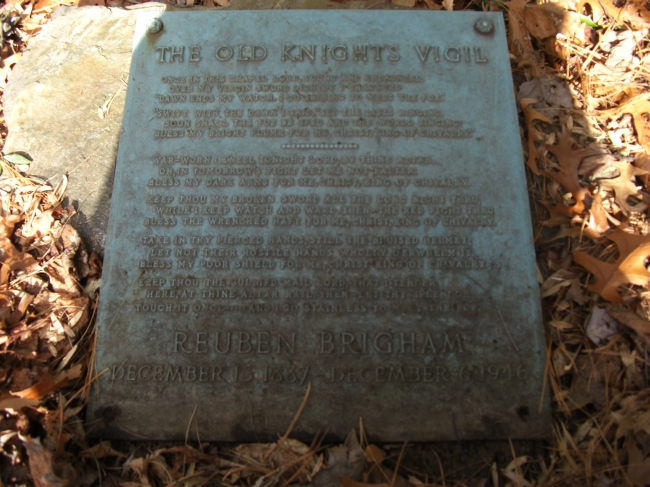
THE OLD KNIGHT’S VIGIL
ONCE IN THIS CHAPEL LORD, YOUNG AND UNDAUNTED,
OVER MY VIRGIN SWORD LIGHTLY I CHAUNTED
“DAWN ENDS MY WATCH. I GO SHINING TO MEET THE FOE.”
“SWIFT WITH THE DAWN” I SAID, “SET THE LISTS RINGING,
SOON SHALL THE FOE BE SPED AND THE WORLD SINGING
BLESS MY BRIGHT PLUME FOR ME, CHRIST, KING OF CHIVALRY.”
••••••••••••••••
WAR-WORN I KNEEL TONIGHT BY THINE ALTAR.
OH, IN TOMORROW’S FIGHT LET ME NOT FALTER!
BLESS MY DARK ARMS FOR ME, CHRIST, KING OF CHIVALRY.
KEEP THOU MY BROKEN SWORD ALL THE LONG NIGHT THRU,
WHILE I KEEP WATCH AND WARD THEN-THE RED FIGHT THRU
BLESS THE WRENCHED HAFT FOR ME, CHRIST, KING OF CHIVALRY.
TAKE IN THY PIERCED HANDS, STILL THE BRUISED HELMET;
LET NOT THEIR HOSTILE HANDS WHOLLY OERWHELM IT.
BLESS MY POOR SHIELD FOR ME, CHRIST, KING OF CHIVALRY.
KEEP THOU THE SULLIED MAIL LORD, THAT I TENDER
HERE, AT THINE ALTAR RAIL, THEN-LET THY SPLENDOR
TOUCH IT ONCE ••••• AND I GO STAINLESS TO MEET THE FOE.
REUBEN BRIGHAM
DECEMBER 13, 1887-DECEMBER 6, 1946
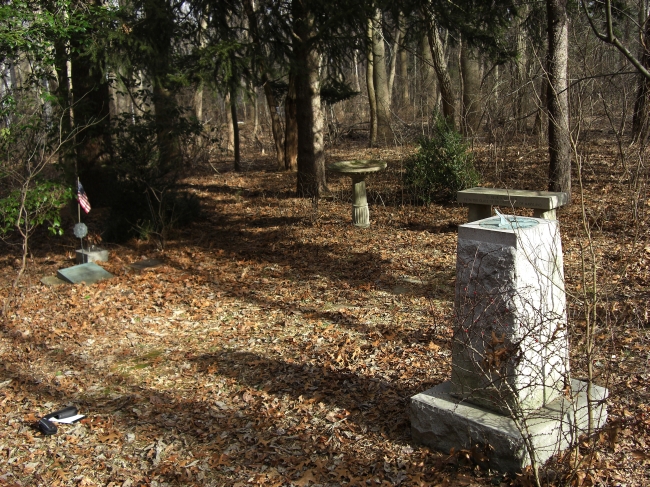
Marjorie Snowden Brigham's marker at gravesite (Brigham's wife)
American Legion marker at gravesite
University of Maryland marker, Class of 1908, at gravesite
University of Maryland marker, Class of 1908, at gravesite
Sundial, from "Friends in Agriculture", at gravesite
More Recent Material
Executive Etchings, by a family member
Comments from Mr. Thomas Street, April 28, 2010 [formerly a T264 Troop Committee chair, now a member of the County Executive's office for Montgomery County, MD]:
I recently read [Jim's] history of the Troop and that of Reuben Brigham. Please tell Jim that Reuben’s other son’s name, (Dave’s brother) was Arthur P. Brigham. (That is old Dave’s brother, not young Dave’s). Even though both were much older than me, both were friends of mine.
Art is now deceased. He died from a brain tumor in, I think, 1993 at the age of 63. Although 7-8 years younger than Dave, he predeceased him. Art was the Public Information Officer for WSSC until the late 1980’s when he retired and moved to Arkansas. Art’s wife Helen, is the great-granddaughter of J.I. Case, founder of the Case Equipment Company. If you google Arthur P. Brigham you will see that he and Helen were founders of the Case Heritage Foundation, a non-profit developed in support of preserving the history of steam and other farm equipment. He, like Dave, was a tremendous individual and a dear friend.
Art was also an early scout in Troop #130 (264), and his two sons, John and Mark, are also Eagle Scouts out of a troop down in Silver Spring.
BSA Troop 264 picture, from 1990 as a PDF file, also as JPEG image (3.7 MB). Dave Brigham
(Reuben's son) is in the back row, upper right. Picture courtesy of Scoutmaster
Dennis Bogan.
More Troop History
| |
